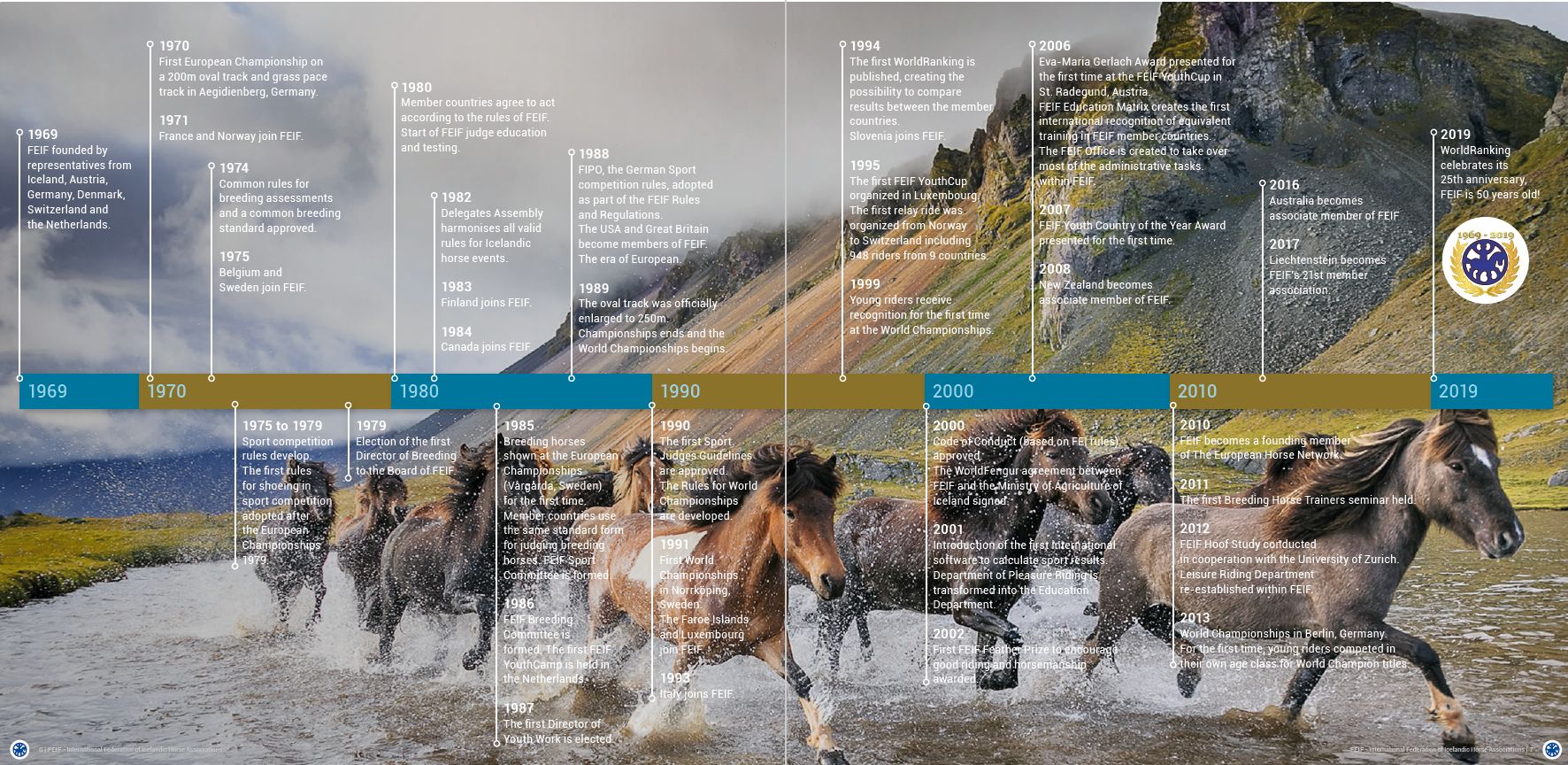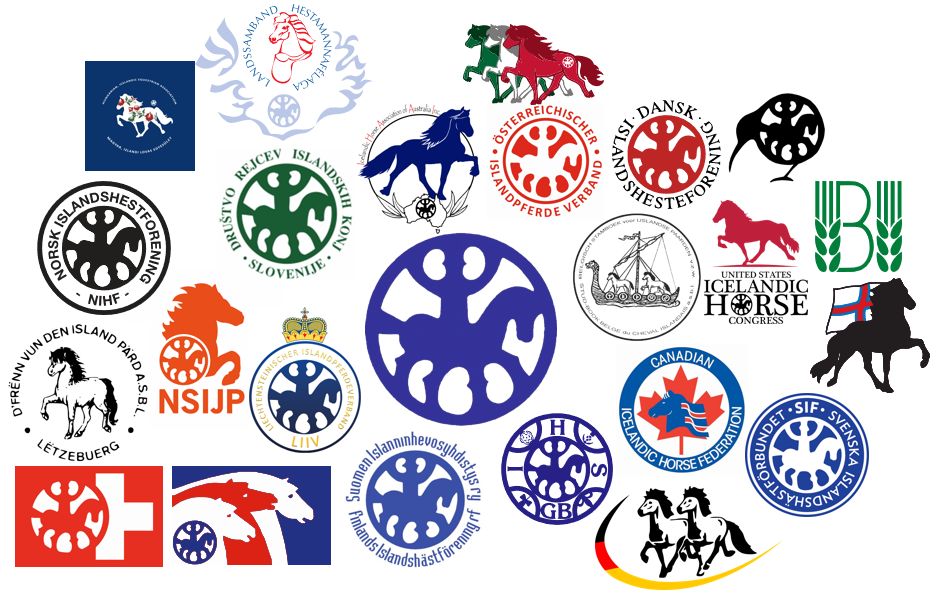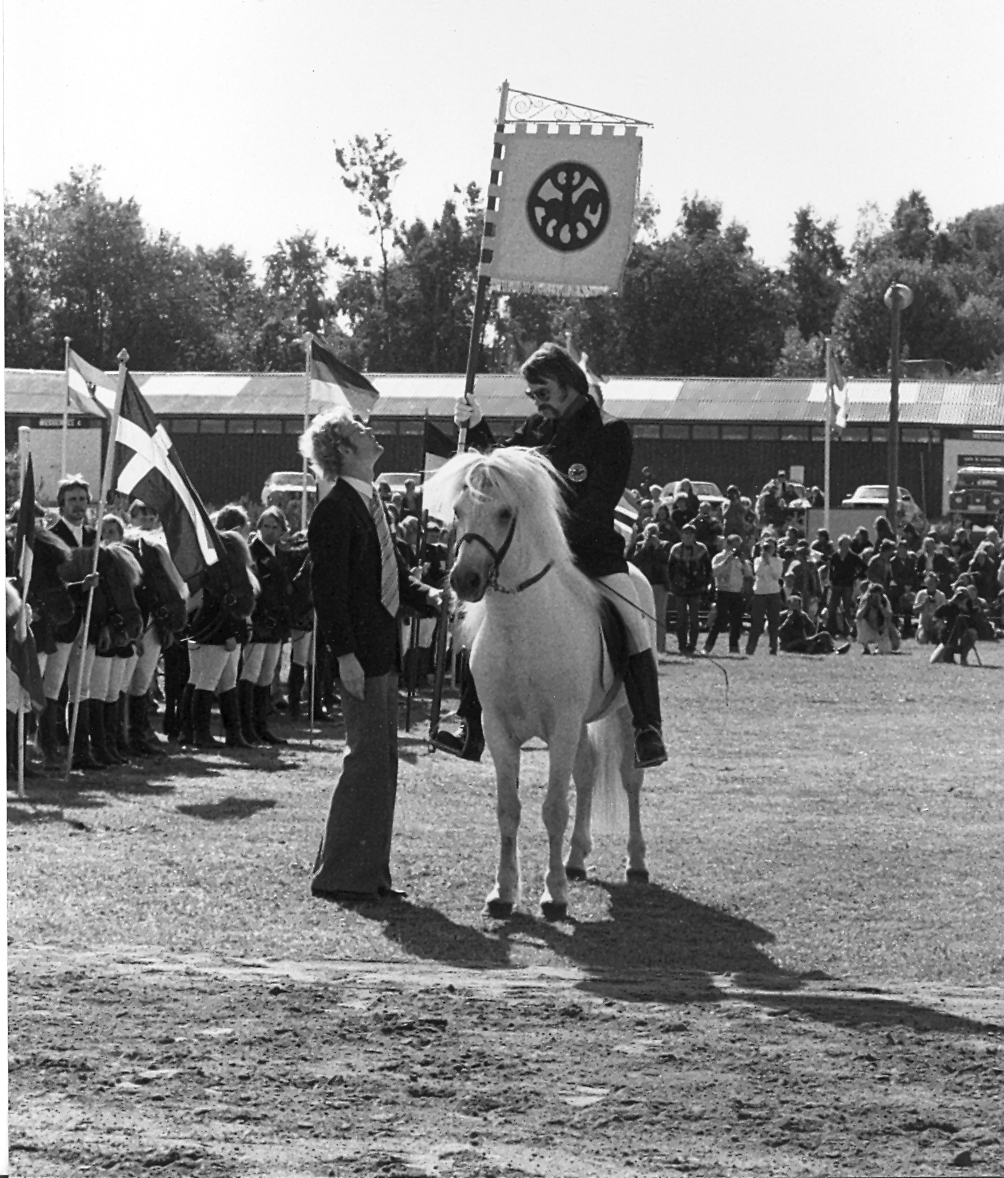History of FEIF

Beginning of the Story
FEIF was started by some Icelandic horse enthusiasts in 1969, on May 25. The founders were: Gunnar Bjarnason (IS), Gunnar Jonsson (DK), Max Indermaur (CH), Walter Feldmann senior DE and the first president, Ewald Isenbügel (CH).
The name they gave the organisation was a statement of what they were, friends of the Icelandic Horse: Föderation Europäischer Islandpferde Freunde (FEIF). Nowadays FEIF stands for International Federation of Icelandic Horse Associations.
For the first six years of its existence, FEIF had no official logo. Inge Høivik, a noted Norwegian silversmith, designed the familiar symbol we now know at the FEIF logo as a signet. The Norwegian association donated the symbol to FEIF and it was adopted as the official logo in 1975.


Statutes, Board and Committees
The FEIF statutes were approved in 1969 and the first board had the following positions: president, vice-president, secretary, treasurer and a sport-leader. Over time a representative for breeding, youth, public relations, pleasure riding and education where added to the board. Today the board positions are: president, representatives for breeding, education, leisure riding, sport and youth work and 1-3 additional board member. The vice president is appointed among these board members. The secretary and account matters are today taken care of by paid resources.
In the beginning the FEIF board was handling all matters by themselves and by the time they invited skilled friends to help. It took nearly 20 years before the first official committee was established with the sport committee in 1987. The sport leader appointed the members at that time, today all departments have one or more committees, formally elected at the respective Annual Meetings.
Member Countries
The member countries were 6 in the founding year: Austria, Denmark, Germany, Iceland, the Netherlands and Switzerland. In 1971 France and Norway joined followed by Belgium and Sweden in 1975. Then from the beginning of the eighties until today the organisation has grown with: Finland, Canada, Great Britain, USA, Faeroe Islands, Luxembourg, Italy, Slovenia, Liechtenstein, Hungary, Australia, New Zealand (as associated member) and Ireland (Ireland has later left FEIF due too few members). Today FEIF has 22 member countries.
From the very beginning FEIF has been ruled by a Delegates’ Assembly which meets once a year. All important decisions have been made at this yearly meeting. In the beginning every country had two delegates each with one vote. Then for a long period the “big” countries had two votes and the smaller countries had one. The voting was strictly personal. The yearly fee was calculated per member in the country with a minimum and maximum limit. Some bigger revisions have been made to the statutes and today there is a floating system where the current number of members regulates both fee and votes. Today one delegate alone can represent their country and use all the votes on the country’s behalf.


From 2005 all the annual meetings have gathering at the same weekend under the name “FEIF Conference” and since 2007 this conference starts with the FEIF Delegates’ Assembly.
2005 – Copenhagen, DK
2006 – Amsterdam, NL
2007 – Glasgow, GB
2008 – Reykjavík, IS
2009 – Hamburg, DE
2010 – Odense, DK
2011 – Vienna, AT
2012 – Malmö, SE
2013 – Strasbourg, FR
2014 – Reykjavík, IS
2015 – Copenhagen, DK
2016 – Haarlem, NL
2017 – Helsinki, FI
2018 – Stockholm, SE
2019 – Berlin, DE
2020 – Hveragerði, IS
2021 – virtual
2022 – Oslo, NO
2023 – Stockholm, SE
2024 – Luxembourg, LU
2025 – Vienna, AT
Delegates Assembly, Annual Meetings and FEIF Conference
The Delegates’ Assembly has been carried through annually since the start. For more than 25 years, absolutely all final decisions were taken there, even details of the sport and breeding rules. The assemblies were often held the day after the European Championships or Landsmót in Iceland to create less travel costs for the countries. It must also be mentioned that most delegates paid all costs themselves for the first 10 – 15 years.
The start of delegating power and influence was the establishment of the annual meeting for national sport leaders in 1988. The other departments followed year by year and today all elections of committee members belong to the annual meetings and so do also all technical discussions and many “smaller” decisions.

International Events with Icelandic Horses
The first international event with horses, the European Championships for Icelandic Horses, was arranged in Germany 1970 with 26 participants from 6 countries: Austria, Denmark, Germany, Iceland, the Netherlands and Switzerland.
The next two championships were held in 1972 and 1975 and from then they have been held biennially with no break. From 1991 the named changed into World Championships, and the participants now came from 18 countries, Canada and USA included. From 1985 breeding horses were also shown at the championships in a special breeding show.
As FEIF was growing, also the number and type of events grew. First addition to sport and breeding was the FEIF YouthCamp, now biennial from 1986 (with exception of 1996, which was delayed to 1997) and then the FEIF YouthCup, biennial as well from 1996.
Due to the popular World Ranking system, established in 1993, ranking the sport riders in all the “important” tests, hundreds of competitions worldwide are open to riders from any FEIF country every year.



Sport
Tracks and Tests
The international cooperation was, due to the big interest for competitions, first worked out in the sport area, with the creation of rules for riding, tracks and equipment. Much has changed from the first years, but the main ideas for the tracks, and also the basic thoughts of gait competitions have survived.
The first rulebook, the IPO, was decided in 1976 lateron called FIPO. In spite of many creative proposals during the years, the oval-track and the strait pace-track are still sound and healthy. And in a way the “mehr-gang” competition, where the riders showed the gaits on the oval track with a choice of pace or fast-tölt in the last round, is not very different from the four and five gait tests we have today.
Rules
In the beginning the sport rules were agreed upon for the international competitions every second year.
Some countries used these rules also nationally, but others made their own national rule books. Growing international activity “forced” more and more countries to adopt the rules, which since 2006 have been accepted and used in all member countries.
Since 2017 FIPO, FIRO and FIZO have been merged in the FEIF Rules & Regulations.
Sport Judges
The big interest for the European/World Championships also forced sport judges’ education and qualification. In the seventies international judges were simply introduced and recommended by each other and the aim was first of all to have international variety.
Regular seminars and big efforts from the member countries to support this education have brought us to the situation today where more than 100 sport judges from 13 countries have qualified as International FEIF judges through an official test.
Breeding
Standard of the Icelandic horse
The second area to cooperate on was breeding, though this was much more complicated than the cooperation concerning sport. Even if an international standard for the Icelandic Horse was agreed upon as early as 1974, it was a long way to reach common rules for the evaluation of and the criteria for approving a stallion to serve mares.
Deciding the Breeding Goal
The development went in two directions, the official FEIF breeding rules based on the Icelandic rules and the “German” rules. Germany had through many ears developed breeding rules, which they were pleased with and wanted to keep. The two systems, however, were after years so different that the results were not comparable and therefore not equally approved in the different countries.
Breeding Judges
During the years of disagreement there were educated breeding judges on both sides, but for the international breeding shows connected to European/Wolrd Championships there was always an Icelandic judge in the group of judges and the official FEIF system was used.
WorldFengur
The break through was doubtlessly a result of the establishment of WorldFengur, our superb database for Icelandic horses. WorldFengur stores the individual results of breeding evaluations of all horses judged at approved shows by the approved number of qualified FEIF breeding judges. Today all FEIF countries fully support the FEIF Rules and Regulations and other evaluations do no longer take place.




Youth
Camp and Cup
The cooperation of youth work started in 1986 with the YouthCamp in Germany and the first youth secretary was elected into the FEIF board in 1987.
The youth department has been very successful and is today organising the Youth Camp and the Youth Cup.
The two events take place in the different member countries in turn, the camps with borrowed horses, the cups normally with “own horses”. Both the camp and the cup have a huge importance for the friendly international atmosphere and friendship across borders, which still is the main aim of FEIF.
Young riders at the World Championships
More professionalism is also influencing the young riders and since 1999 the best young riders have been especially honoured at the World Championships.
In 2003 the national teams could for the first time add 3 extra young riders for World Championships. Nowadays, countries may send up to 5 young rider/horse combinations. Since 2013, young riders have their own A-finals, and B-Finals were introduced in 2019 for classes where more than 20 young riders were entered.
Youth Tests
The international youth work has of course also invented youth riding tests and rules for youth events. Many of these tests, originally dedicated to young rider’s competitions, are used as “all age rules” at local competitions worldwide.
Today all these rules are collected in the FEIF Rules and Regulations.
From Pleasure Riding to Leisure Riding
For some years from 1993 FEIF had a board member to work for the pleasure riders, who were described to be riders with not so much interest for sport competitions or showing breeding horses, but focusing on riding in the country side.
All-ride competitions were introduced to the members and a lot of work was done to establish cooperation about riding routes across borders and also exchange of members. It soon showed to be difficult to organise activities for pleasure riders.
In 2012 FEIF established a Leisure Riding Committee. The largest number of riders joining the Icelandic horse world do so as the Icelandic horse offers wonderful adventures when riding in the country side.
Many of these riders have limited interest in sport competitions or showing breeding horses, but focus on riding in the country side. The Leisure Riding Committee seeks to map the work done at national level to secure that riders have also in future access to nature and will in future work to build a platform for supporting this work.
Relay Rides
The idea of the relay rides was that it started in the member countries ending up at the World Championships area during the championships. The first ride took place in 1995, from Norway to Switzerland and from this ride a logbook with stories from the whole ride was printed and sold.
Two years later the ride went from Switzerland to Norway. Then a “star-ride” was made with riders from several directions meeting in Germany. The tradition of these rides still exists, but year-by-year, the responsibilities for the arrangement is overtaken by the countries involved. In 2013 it involved a successful event with 300 horses in the center of Berlin, Brandenburger Tor.



Education
From 1998 the pleasure-riding department took more and more interest in education and from 2002 the name “pleasure riding” disappeared from the FEIF board. Education matters were for years a part of the other departments, like sport, breeding and youth, and from 1998 to 2002 it was a special part of the pleasure-riding department.
The progress in, and the interest for, international cooperation about education has been enormous. The seminars for trainers, held annually since 2003, have the absolute FEIF record of participation, with more than 100 taking part in 2004.
Many of the member countries have established good education programmes for instructors and the aim for FEIF has first of all been to compare the systems and make possibilities for instructors to enter courses in “foreign” countries. With the signing of the “Education Matrix” in 2006 this aim has been reached.
Ethics and Morals
High morals in all fields and sticking to the highest ethical standards have been at the fore front of attention for FEIF from the start. The board of FEIF, the delegates and the countries have been diligent and disciplined in keeping to this high standard.
Since 2000 the “Code of Conduct”, adopted from FEI, has been an over-all rule for us. The FEIF Rules and Regulations also describe in many chapters how to deal with ethical matters both through preventive methods and a punishment system.
Development and Changes towards the Future
During the past 50 years FEIF has grown from a few hundred members to nearly seventy thousand and developed in all directions. There has been some criticism that changes take too much time, but this is a consequence of total democracy of the 22 member countries. There is a huge interest from the member countries to participate where decisions are taken and there is also a genuine willingness from the most skilled horse people to share their knowledge with the organization by taking places in the many committees.
The Icelandic horse is in many countries the fastest growing horse breed in terms of numbers. The professional leadership from the FEIF board, the national organizations and the efficient committees secure that this development will continue into the future.



Original text by Tone Kolnes, former FEIF president, with updates
Photos on this page: Ewald Isenbügel, Henning Drath, Tone Kolnes, Kari Baklund, Neddens Tierfoto, Horses of Iceland